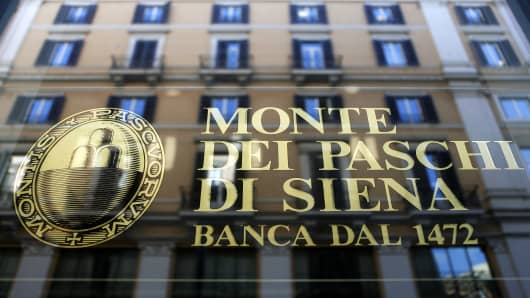Monte dei Paschi's risk control unit and its own internal audit team were alarmed about the department responsible for a series of opaque structured finance deals at the troubled bank as long ago as November 2009, bank documents show.
The documents, obtained by Reuters, add to a growing picture of a badly weakened bank pitching into crisis following its costly 9-billion-euro acquisition of rival Antonveneta just before the global financial meltdown of 2008.
That purchase and a complex series of loss-making derivatives and structured finance trades have left Italy's third-largest bank dependent on state aid and shaken the country's financial and political establishment less than a month before national elections.
(Read More: Italy Central Bank Approves Monte Paschi Bailout Request)
They have also raised growing questions about how managers at the bank were allowed to avoid action by regulators despite a growing array of warning signs that the situation was spinning out of control.
The bank has said that complex trades which only came to light recently could cost it 720 million euros ($970.42 million).
Several senior sources at the bank said the finance department, run by an executive named Gian Luca Baldassarri operated like a bank-within-a-bank, loading up on complex derivative trades and risky hedges with little oversight from top management.
The Bank of Italy and Monte Paschi's new management team have said that at least one of the trades was deliberately concealed from regulators and not revealed until documents were found hidden away in a safe and discovered in October.
The documents quote a report from the bank's risk control unit after an audit carried out between Aug. 5-Sept 30, 2009, which uncovered "systematic overshooting of risk limits" in the management of the group's 24-billion-euro proprietary portfolio.
The inspectors also singled out "deficiencies in controlling the compliance of contract documents related to structured operations and/or derivatives positions".
Some contracts were "not always in line with the best market valuations" and the indicated value of some positions did not reflect their mark-to-market value, the documents said.
The bank's senior management at the time was forced out last year, with managing director Antonio Vigni leaving with a 4 million euro payoff that the Bank of Italy is now contesting. Chairman Giuseppe Mussari stepped aside in April.
Bank sources Reuters has spoken to said neither men fully appreciated what was happening at the finance division and attempts by other board members and internal auditors to flag the risks were unsuccessful.
"They could do what they wanted because no one really understood what they were doing, neither Mussari nor Vigni," said a former mid-level bank official.
No comment was available from Baldassarri. Vigni declined to comment. Mussari, who last week had to step down as chairman of the Italian banking lobby, did not return calls.
"Red Hot"
The case is now the subject of a criminal investigation by prosecutors in Siena, the Tuscan town where the bank has been based since it was founded in 1472.
According to judicial sources, investigators are focusing on allegations of bribery and fraudulent accounting and several senior executives, including Baldassari, have been named in the investigation, according to court documents seen by Reuters.
The head of the Siena prosecutors office, Tito Salerno, declined to comment directly. "We cannot say anything, it is a complex, red-hot investigation and we have a long way to go," he told reporters.



